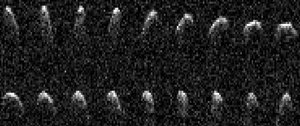25143 Itokawa
|
|
| Discovery A (http://cfa-www.harvard.edu/iau/lists/NumberedMPs.html) | |
|---|---|
| Discoverer | LINEAR |
| Discovery date | September 26, 1998 |
| Alternate designations | 1998 SF36 B (http://cfa-www.harvard.edu/iau/MPDes.html) |
| Category | Apollo asteroid, Mars-crosser asteroid |
| Orbital elements C (http://asteroid.lowell.edu/) Epoch 21 March, 2005 (JD 53450) | |
| Eccentricity (e) | 0.280078 |
| Semi-major axis (a) | 1.32388 AU |
| Perihelion (q) | 0.9531 AU |
| Aphelion (Q) | 1.6947 AU |
| Orbital period (P) | 1.5233 a (556.38 d) |
| Mean orbital speed | unknown |
| Inclination (i) | 1.622° |
| Longitude of the ascending node (Ω) | 69.095° |
| Argument of perihelion (ω) | 162.756° |
| Mean anomaly (M) | 197.445° |
| Physical characteristics | |
| Dimensions | 607x287x264 km |
| Mass | unknown |
| Density | unknown |
| Surface gravity | unknown |
| Escape velocity | unknown |
| Rotation period | 0.5055 d |
| Spectral class | unknown |
| Absolute magnitude | 18.957 |
| Albedo | 0.53 |
| Mean surface temperature | unknown |
25143 Itokawa is an Apollo and Mars-crosser asteroid discovered in 1998 by LINEAR. It is named after Hideo Itokawa, a Japanese rocket scientist.
Itokawa is believed to be an S-type asteroid in composition. It has been imaged by radar astronomy at Goldstone, revealing a somewhat elongated shape and a 12.5 hour rotation period. [1] (http://echo.jpl.nasa.gov/~ostro/itokawa.html)
Itokawa is the target of the Japanese Hayabusa space probe, which will land on and take samples of the asteroid's surface in 2005.
... | Previous asteroid | 25143 Itokawa | Next asteroid | ...
| The minor planets |
| Vulcanoids | Main belt | Groups and families | Near-Earth objects | Jupiter Trojans |
| Centaurs | Trans-Neptunians | Damocloids | Comets | Kuiper belt | Oort cloud |
| (For other objects and regions, see: Binary asteroids, Asteroid moons and the Solar system) |
| (For a complete listing, see: List of asteroids. For pronunciation, see: Pronunciation of asteroid names.) |

